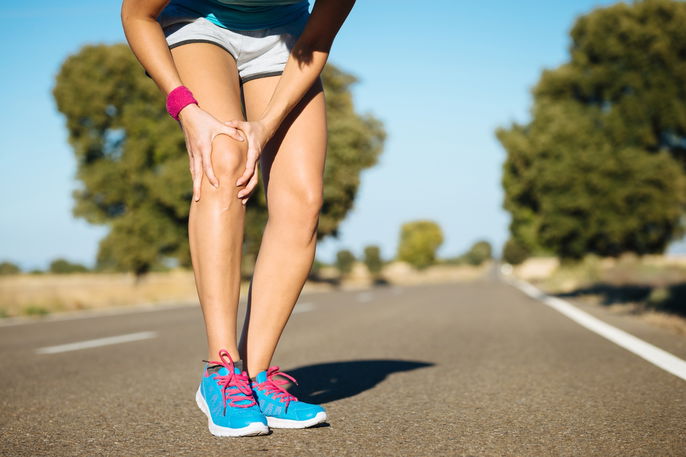To relieve knee pain after running you can try applying a cold compress or a topical anti-inflammatory like ibuprofen or diclofenac. If necessary, you can also substitute walking for running until your pain improves.
This type of knee pain may be the result of a condition called iliotibial band syndrome (ITBS), or "runner's knee", which occurs more frequently in people who run every day. It is typically characterized by pain on the outside of the knee.
Knee pain after running can also be the result of other problems such as joint wear or tendinitis. If the pain worsens or does not resolve within a week, the recommendation is to stop running and consult an orthopedic specialist or your primary care provider in order to identify a cause and arrange for the best treatment.

Tips & strategies
Ways to help relieve knee pain after running include:
1. Resting
To help relieve knee pain after running it is important to rest and avoid strenuous activities like jumping, biking, and speed walking to avoid aggravating the problem and making the pain worse.
Recommendations include lying on the bed or sofa and propping your knee up on a pillow for at least 20 minutes to help decrease swelling and inflammation.
2. Applying cold compresses
Icing your knee can help reduce pain and inflammation, especially when the knee appears red and swollen.
To make a cold pack, place ice in a thermal bag or a plastic bag and cover it with a clean, dry towel to prevent burning the skin. Apply the cold pack to your knee for about 15 minutes at least twice a day, including immediately following your run.
After applying the cold pack, you can also use some of the ice to massage the knee, moving the knee cap from side to side over the course of 3 to 5 minutes.
3. Using a foam roller
A foam roller is an excellent tool to help relieve pain in the knees, calves, quads, and back.
Lie on your side and place the foam roller under the side of your knee (or other painful area), gently rolling the foam roller back and forth for 5 to 10 minutes.
Large foam rollers that are firm enough to support your body weight are preferred.
4. Applying a topical anti-inflammatory
Applying a topical anti-inflammatory to the knee, such as diclofenac topical gel or methyl salicylate cream, is a good option to treat knee pain at home after a run.
These topical medications help treat pain and reduce inflammation in the knee and can be used 1 to 2 times per day by massaging the gel or cream gently into the skin.
5. Using a knee band
Wearing a knee band during the day helps to immobilize the knee and decrease pain while promoting a sense of stability and comfort.
Using a knee band while running can also help reduce pain.
6. Taking analgesics and anti-inflammatories
Taking an analgesic or anti-inflammatory, such as acetaminophen or ibuprofen, can help decrease knee pain and inflammation after running.
Make sure to only use these medications as directed by a doctor or your primary care provider. See pain medicine.
7. Performing gentle stretches
When knee pain arises during or right after a run it is important to stretch the knee gently by bending the knee back and holding the position by securing your foot with your hand (standing quad stretch). You can also try sitting in a chair with your feet flat on the floor and slowly extend the affected knee.
8. Eating anti-inflammatory foods
Foods like turmeric, broccoli, and spinach, as well as foods rich in omega-3s like tuna, sardines, salmon, flax, and chia seeds, can help reduce inflammation and may help relieve or even prevent knee pain associated with running.
These foods should be consumed daily or, in the case of fish, at least 3 to 5 times per week. Check out more anti-inflammatory foods.
9. Wearing running shoes
It is important to wear running shoes with good shock absorption to reduce the risk of injury and prevent knee pain after running.
When you are not running, make sure to wear comfortable, supportive shoes with rubber soles no thicker than 1 inch (2.5 cm).
If possible, try running on trails or dirt roads instead of pavement to reduce the impact on your knees.
Also recommended: Knee Pain: 11 Causes & How to Treat (Medical + Natural Relief) tuasaude.com/en/knee-painWhen to see a doctor
It is important to consult a doctor in the following situations:
- Knee pain that is severe or worsens over time;
- Swelling of the knee;
- Redness of the knee;
- Difficulty walking or bending the knee;
- Fever.
Your doctor or primary care provider will examine the knee and may order tests like an X-ray or CT scan (computed tomography scan) to evaluate the structures of the knee and decide on the best treatment.
For pain that does not get better after 6 months of treatment, your doctor may recommend a procedure called an arthroscopy, which is a minimally-invasive surgical procedure that can be used to diagnose and treat knee problems.






























